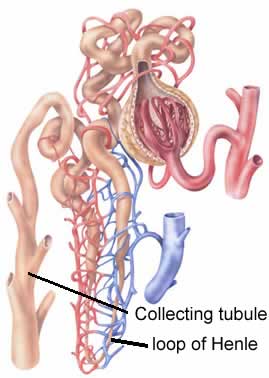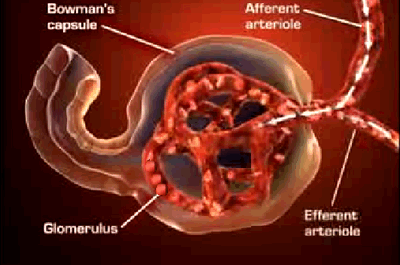
The renal artery enters the kidney and divides into smaller and smaller blood vessels known as capillaries. Red blood cells are forced to squeeze through these capillaries in single file.
The excretory process in the nephron involves two stages. These include filtration and reabsorption. Filtration occurs in the glomerulus and reabsorption occurs in the collecting tubule along the loop of Henle. Here all amino acids, glucose and most of the salt that passes through the wall of the tubule is reabsorbed back into the capillaries. 99% of the water that is filtered in the glomerulus is reabsorbed in the collecting tubule. Click to see an animation. The kidney regulates the volume of water present in the blood by adjusting the amount of water that is reabsorbed in the tubule. When the body is dehydrated, more water is reabsorbed and the urine becomes more concentrated. Conversely, if the blood contains too much water less water is reabsorbed in the tubule and the urine becomes very dilute.
Lets see how the glomerulus works.
Filtration is a straightforward process and occurs as a result of relative high pressure inside the capillaries and low pressure in the Bowman's capsule. The fine capillaries of the glomerulus have porous walls. Through these pores flow small molecules such as water, glucose, amino acids and waste products. Red blood cells and giant protein molecules are too big to squeeze through these pores and remain inside the blood vessels.
Click to see an animation of how the blood is filtered.

1)A football player received a heavy blow to the kidney while challenging for the ball. He later noticed blood in his urine. Explain what happened to the nephrons in the kidney to cause blood to appear in the urine.
2)During a kidney infection, blood and large proteins appear in the urine. What changes to the capillaries may result in this?
3)Antidiuretics are used to control loss of body fluids. A person suffering from dehydration may be given antidiuretics which increase the rate at which water is absorbed through cells. Where do you think antidiuretics are acting, in the glomerulus or the collecting tubule? Explain
4)Caffeine is a natural diuretic.
It increases the volume of water in the urine. On what part of the nephron
does caffeine act to increase the volume of water excreted?
5)Which is the path for liquid waste excretion from the body?
Urine passes from the pelvis of the kidney to the then to the and finally out the .
6)The renal artery supplies the kidney with
7)The two stages of excretion in the kidney are
8)Which is the pathway a glucose molecule is likely to follow as it passes through the kidney?
9) Filtration in the kidney occurs through
10) The fluid filtered in the glomerulus of the nephron (glomerular filtrate) contains no
11) Fluid leaves the capillaries of the glomerulus as a result of
12) Which substance can be
expected to have a higher concentration in the urine than in the blood?
Answer the questions below after viewing the video on the right.
How many nephrons are present in the kidney
Each nephron contains a glomerulus and a set of tubules. A glomerulus is a .
Plasma like fluid escapes from the glomerulus and forms the major constituent of urine. As it passes through the tubules this fluid
The tubules that come off Bowman's capsule are divided into a number of different sectors.
- at the proximal convoluted tubule
- at the Loop of Henle
- at the distal convoluted tubule
- at the collecting tubules
Answer the following questions after viewing the video on the right.
The venus blood returning to the heart as it passes very close to the collecting tubules .
Rapid movement of fluids occurs between the venus blood and the filtrate flowing through the network of tubules.
The venus blood contains more waste than it did when it entered the kidney
The venus blood is composed of only red blood cells as all of the plasma has been removed.
The image on the left shows the glomerules, Bowman's capsule and the afferent and efferent arterioles.
What is the function of each?
Blood pressure in the glomerulus is controlled by constricting and dilating the arterioles.
To increase pressure afferent arterioles are
while the efferent arterioles are
.
What do you think would happen if the pressure in the glomerulus was too high Explain.
